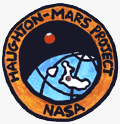The Haughton-Mars logo
the NASA Haughton-Mars project
Artic Expedition Sets Out...
News story originally written on June 19, 1998
A 20-member team will leave for the Artic Circle on June 22nd. They are going to investigate the Haughton meteorite crater and its surroundings on Devon Island in the Artic circle.
Among other techniques, scientists will use a 160-pound autonomous helicopter...no pilot necessary! "The mission provides a great opportunity to demonstrate the feasibility and the value of robotic aircraft for mapping and surveying applications," said Dr. Omead Amidi from Carnegie Mellon University's Robotics Institute.
Beyond testing this new helicopter, scientists are hoping that this expedition will yield insight for future Martian missions. You see, this crater site has similiar geologic features to those found on Mars. Drilling, mapping and investigating may shed light in particular on the early history of Mars, when the planet's climate may have been wetter and warmer.
Some interesting tidbits...the team members of the Haughton-Mars expedition will use all-terrain vehicles to get around Devon Island. They will also 'rent' two dogs to keep at the campsite...to ward off polar bears! The expedition is expected to end July 26th.
You might also be interested in:

It was another exciting and frustrating year for the space science program. It seemed that every step forward led to one backwards. Either way, NASA led the way to a great century of discovery. Unfortunately,
...more
The Space Shuttle Discovery lifted off from Kennedy Space Center at 2:19 p.m. EST, October 29th. The sky was clear and the weather was great as Discovery took 8 1/2 minutes to reach orbit for the Unitied
...more
A moon was discovered orbiting the asteroid, Eugenia. This is only the second time in history that a satellite has been seen circling an asteroid. A special mirror allowed scientists to find the moon
...more
Will Russia ever put the service module for the International Space Station in space? NASA officials are demanding an answer from the Russian government. The necessary service module is currently waiting
...more
During a period of about two days in early May, 1998, the ACE spacecraft was immersed in plasma associated with a coronal mass ejection (CME). The SWICS instrument on ACE, which determines unambiguously
...more
J.S. Maini of the Canadian Forest Service has referred to forests as the "heart and lungs of the world." Forests reduce soil erosion, maintain water quality, contribute to atmospheric humidity and cloud
...more
In late April through mid-May 2002, all five naked-eye planets are visible simultaneously in the night sky! This is includes Mercury which is generally very hard to see because of its proximity to the
...more















